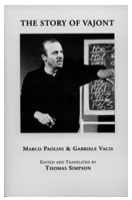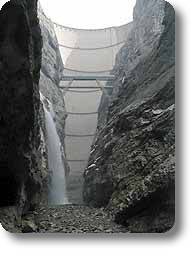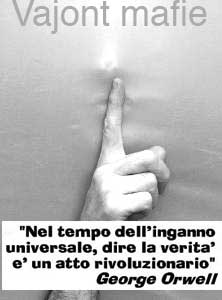(Translations)
 Marco Paolini, Gabriele Vacis
Marco Paolini, Gabriele Vacis
The Story of Vajont
Thomas Simpson, ed. & tr. Boca Raton,
Florida.
Bordighera, 2000. ix + 116 pages,
ill., $13.
ISBN1-884419-41-0
I REMEMBER THAT many years ago I reviewed here a book about the very Italian
tragedy of the collapse of the Vajont dam
(Stramalora, by G. A. Cibotto). Now Thomas Simpson, a lecturer in Italian at Northwestern University, has translated Marco
Paolini's work that retells the awesome
event in topical-historical terms (the two
descriptors are not contradictory when
referring to this tragedy).
The Story of Vajont represents the written version - i.e., a compendium - of a
«one-man show» that Paolini has given all
over Italy since 1993 in various piazzas,
cultural centers, schools, and factories,
ending up on television (9 october, 1997, live TV broadcasting, in front of the dam) with a very large
audience, over 3,5 millions astonished people. In the theatrical version, Paolini was directed by Gabriele Vacis. However, even when Paolini faces an audience, he presents himself as a cultural
operator rather than an actor, in the
sense that he leaves the scenic dimension
in order to merge with his audience
through the reevocation. The spectators,
like the readers, are constantly called on
to question and seek out the reasons for
what happened in 1963. In this, Paolini
shows he has absorbed his friend and
mentor, Nobel prizewinner, Dario Fo's lesson on retelling.
On bare boards where the only prop is a school blackboard, Paolini asks for, and then explains the weight of a cubic meter of water ... because on that Wednesday,
9 October 1963, at 10:39 P.M., a gigantic wave (an artificial, provoked megatsunami!) containing twenty five million cubic meters of water shot out of the Vajont dam because
two thousands sixty million cubic meters of rock had
just crumbled from Mount Toc into the
artificial lake formed by the dam.
Five
entire small towns were swept away,
about two thousand were dead, and
at the time it was said that with that
landslide came the beginning of the end
of the Italian postwar 'economic miracle'.
Thirty years later, the wounds caused
by the tragedy are still unhealed, thanks
to the slowness of an Italian bureaucracy
that thrives in the shadow of the political
inefficiency of the successive governments since that time.
 This truth emerges
from the parliamentary reports: the
neverending history of compensation to the families of the survivors, of opposition's parliamentary questions that elicit only vague
replies, of houses rebuilt but not registered, rendering uncertain property taxes
and inheritances.
This truth emerges
from the parliamentary reports: the
neverending history of compensation to the families of the survivors, of opposition's parliamentary questions that elicit only vague
replies, of houses rebuilt but not registered, rendering uncertain property taxes
and inheritances.
In other words, it is a
damnatio memoriae that makes every day
another black October 9th for the inhabitants of Longarone, Erto, and Casso.
The polemical account by Paolini and
Vacis is presented with rhythmic brio,
and Thomas Simpson's translation renders the highlights of the story faithfully
and expressively. In my opinion, some
unfounded pseudohistorical details detract from the value of the account: for
instance, the fact that it was the new Fascist regime that planned the dam as a
source of energy to strengthen its program of economic self-sufficiency, forgetting that in 1929 any liberal-democratic
government of any European country
would have acted in the same way, because that was the accepted economic
policy trend in Europe then.
Finally, there is an excellent third
chapter wherein Franco Nasi of the University of Chicago offers an interesting
contribution on the language and ritual
of the storyteller.
According to Nasi (here, in italian, Franco Nasi's biography on www.zam.it) «a
true storyteller like Paolini must possess
the ability to transform an extraordinary
event into a social and intellectual experience, making it flow outward from the
usual channels of information to become
part of a lasting collective memory».
by Giovanni d'Angelo,
Piancastagnaio (Siena), Italy, 2000
This page edited from: Tiziano Dal Farra
- Hugest Vajont dam disaster archive (almost in italian) just pointing there.
Photo, books on the theme, even rare videos. Even HERE on Vimeo
Problemi col sito?
Dissensi? Commenti?
Informazioni?
Write me/Escrìbeme/Schreib mir/Scrivimi

